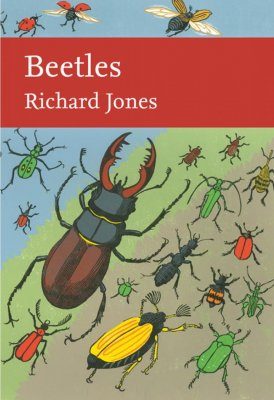
These are the basic pigmented colours of most beetles, but these colour descriptions were seldom used in beetle books until fairly recently. Instead, a series of mysterious jargon terms, bordering on the arcane, were employed. Many years ago, a prominent and expert lepidopterist sidled up to me at an entomological meeting and asked in an undertone, so others would not overhear his ignorance, what ‘testaceous’ meant. This word, used frequently in old beetle books to mean a slight orange-yellow or reddish pink, was almost unknown to students of other orders. From the Latin testa, meaning ‘tile’ or ‘shell’, there was an implication of texture and light quality related to old clay roof tiles, snails and seashells, and it describes perfectly the translucent pinkish-yellow limbs of the 22-spot ladybird (Psyllobora vigintiduopunctata), where ‘yellow’ implies the colour of its much garishly brighter elytra. Other abstruse (but quaintly delightful) colour terms include: piceous (or pitchy), reddish black, the colour of pitch; castaneous, deep chestnut, reddish brown; fuscous, dull brown; fuliginous, the deep, opaque black of soot; rufous, pale red; luteous, egg-yolk yellow with a hint of red; sulphurous, brimstone yellow with a hint of green; and my personal favourite, ferruginous, a yellowy or brownish pink reminiscent of leaching rusty iron.
Many beetle colours, particularly the bright metallic sheens so distinctive of some groups, are not, however, the result of pigments, but are an artefact of submicroscopic structures on the cuticle. Parallel grooves and ridges across the hard cuticle of the head, pronotum and elytra, or indeed any of the armoured sclerites or segments of the legs or antennae, catch and reflect particular wavelengths of light while absorbing or scattering others. Just as sunlight passing through cut glass projects a spectrum of rainbow colours, refracting the slightly different wavelengths in slightly different directions, light is split when it hits the precisely aligned ridges on a beetle’s cuticle, which form a diffraction grating. Depending on the periodicity, shape and size of the ridges, particular colours are preferentially reflected. This gives the glinting, reflectively metallic appearance so entrancing in many beetles, and accounts for the sometimes shifting colours as the animal alters its position in the sunlight, or the specimen is moved under the microscope lamp. These non-pigment structural colours are found throughout the insects, notably in blue morpho butterflies (Morpho), demoiselle damselflies (Calopteryx), blue- and green-bottle flies (Calliphoridae) and ruby-tailed wasps (Chrysididae), but nowhere are they more widespread or more resplendent than in the beetles.
A few glinting, metallic tropical species have become widely touted as living jewels (mainly cetoniine chafers, buprestids and leaf beetles), and their images regularly appear in books and magazines and on the Internet whenever the close-up wonders of a wildlife safari in miniature are required. However, even the commonest of British ground beetles are a marvel when seen in the right conditions. I’ve had many a squelching boot-full after sliding gently into the water when trying to grab at the tiny, glinting Bembidion and Elaphrus ground beetles that haunt the damp herbage on stream and pond banks. Their shining bronze bodies, sparkling in the bright sun, are deceptively difficult to intercept with finger and thumb as they dash between drip-bespeckled stems and roots, and my concentration was stretched to the point of failing to keep a proper monitor on my overall balance, with the inevitable wet and muddy consequences.
Elsewhere, beetles get their colours and textures from various hair- or scale-like outgrowths on their bodies. They can be furry (the dung rove beetle Emus hirtus), prickly (the weevil Sciaphilus asperatus; Fig. 13), tufted (the longhorn Pogonocherus hispidus) or velvety (weevils in the genus Cionus). There is a spectrum of varieties to befuddle the beetle student, but a few simple definitions will make a start. The bodies of shining ground beetles are mostly smooth, without any hairs (glabrous), but even they have a few slim, whisker-like sensory hairs (bothria, or trichobothria, singular bothrium) usually sticking out of indented pore-like craters, and the precise positioning of these is useful in identification. Other beetles may have a sparse covering of regularly spaced hairs, short and even; this pubescence may be longer (pilose) in some species, or tufted, clumped or feathery (plumose), or contain a mixture of different-sized hairs, ranging up to the longer, taller, more upright spines called setae (singular seta).
In the most extravagantly patterned or variegated beetles the setae are modified to form broad, flattened scales, and just as the same evolution produced the beautiful patterns of butterfly and moth wing scales, so the mosaic of colourful scales across the elytra and pronotum can produce veritable works of art. Some of the most delightful decorations occur in the weevils (Curculionidae and relatives) and hide beetles (Dermestidae), and the scales can be circular, shield-shaped, heart-shaped, triangular or feather-like. They can be flat and brilliantly metallic, but many are ribbed, although this is visible only under the very highest magnifications of top-end professional scanning electron microscopes. Under a hand lens or through a budget stereomicroscope, exactly where a seta becomes a scale is sometimes open to debate, and talk of scale-like setae and seta-like scales punctuates the coleopterological literature.
The author: https://en.wikipedia.org/wiki/Richard_Jones_(entomologist)
@Trinity


